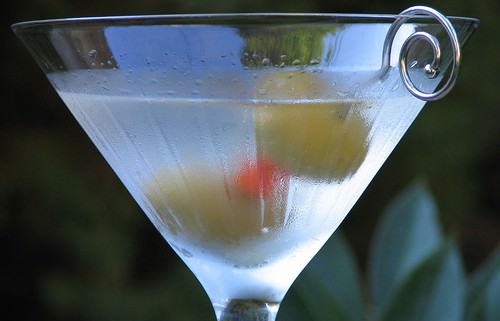The Secret to a Great Martini? Good Communication
Close your eyes and picture the perfect martini. Got it? Okay. What does it look like? Is it crystal clear, awaiting that first sip from within its classic inverted triangle of an “up” glass, garnished with a twist?
No? Well, then, is it in a stout “rocks” glass packed with ice? Are there olives? If so, how many? What does it taste like? Vermouth? Gin? What kind of gin? Or does it taste like vodka? Or does it essentially just taste like the Arctic? Is it “shaken, not stirred”? Or does the mere question fill you with rage?
Define “Martini”
Like it or not, bartenders: even the most basic definition of the word can be called into question today. And we’re not even talking about chocolate martinis or apple martinis. Just the simple question of what comprises a regular, good old-fashioned martini is controversial enough. Fear not, however. All you need to get through this is one thing: as is the case when it comes to any good and fulfilling relationship, the secret to a good and fulfilling martini is also communication.
An experienced martini drinker should certainly know all the elements to proper ordering, but not everyone understands the importance of verbally distinguishing between, say, a “dirty vodka martini on the rocks” and a “dry Tanqueray martini straight up with a twist.” How could they not understand this, you ask? After all, these two drinks have basically absolutely nothing in common, short of containing alcohol! It’s enough to cause an existential crisis. Unless, of course, you cut your customer at the chase by simply coming out and asking what they want.
Blame Agent 007
That’s not to say that it might not be frustrating, on principle. If you get the sense that customers these days need a remedial Martini 101 course, you may be on to something. Some would argue that James Bond has ruined the martini, tossing good cocktail common sense out the window. The very fact that people throw around the phrase “shaken, not stirred” like it’s a mark of sophistication says a lot. Stirring, which waters the gin down less (or, believe this “bruising the gin” nonsense if you prefer) is technically considered the “correct” method for the real purist, although using a metal shaker seems to be the most popular method today.
James Bond has also been blamed in part for the popularity of vodka martinis – a popularity so absolute, in fact, that many patrons now assume a martini is, by default, made with vodka (when actually the opposite is true: it’s gin). And technically, yes (just to further confuse matters), a vodka martini is better shaken than stirred.
While we’re placing blame, though, if a martini comes with an even number of olives (bad luck!), it’s possible that writer/fine beverage aficionado Christopher Hitchens (R.I.P.) could be partly responsible – as it’s possible the bartender could be confusing the odd-number-of-olives rule with Hitchens’ popular “How many martinis should you drink?” adage. (The somewhat racy answer is based on human anatomy and yields an even number – two). But that’s totally just a hunch.
What to Ask
To summarize, then, when customers don’t specify, be sure to ask:
1. Gin or vodka?
2. Do you prefer a specific brand? Or, Is Bombay Sapphire (etc.) okay? (Believe me, some gins taste like practically nothing compared to others, and if you don’t have the brand patrons like, they might prefer a beer, thanks).
3. Straight up? (Served chilled, with the ice strained out, into a chilled “up” glass – the inverted triangle). Or on the rocks? (Poured over ice that’s packed tightly and emerges above the top of the “rocks” glass).
4. Olive(s)? (Remember, make sure it’s an odd number!) Or twist? (Of lemon – and not to be confused with a wedge).
The ratio of the gin (or vodka) to vermouth is 8 to 1 – unless the patron says otherwise. It doesn’t hurt to ask if they want it dry, though. This means less vermouth, i.e., only a few drops (insert joke here about “dry” meaning just having the vermouth bottle nearby). Dry martinis are commonly served with a twist, but definitely ask, since your patron may prefer olives. Adding olive juice really isn’t standard, so if patrons want a “dirty martini,” they ought to say so.
Finally, we’ll leave it up to you to determine whether shaking vs. stirring is even an option at your establishment. If you’re shaking, don’t shake too hard. The mixture should be slightly cloudy but not foamy or bubbly.
Never Too Late to Get it Right
Of course, miscommunications still happen. Watch a patron’s facial expression upon taking that first sip. If you don’t get the thumbs up or look of pleasure, talk it out. Granted, you may be doing so reticently – fighting the urge to shake your head and beg to know, “Is nothing sacred anymore? Why must it be so hard?” And of course the answer is yes, your ability to work some bartending magic is sacred; you know how to figure out what patrons want – even if you’re feeling nostalgic for the good old days.
- Uncorkd Adds New Vendor Purchasing, Tracking and Reporting Functionality - February 13, 2018
- Uncorkd Adds New Inventory Management Functionality with POS Integration - July 24, 2017
- How Many Red or White Wines Should You Have on Your List - May 3, 2016







